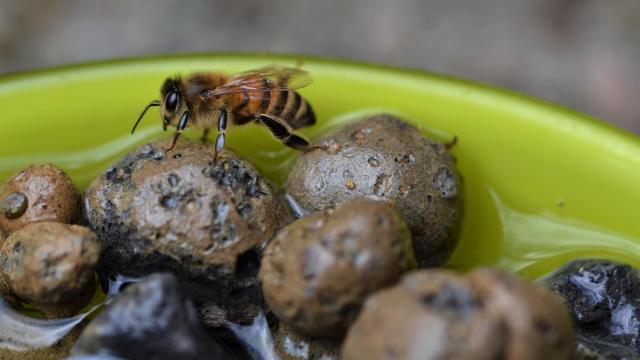While we’ve all been focused on growing a bee-friendly habitat in our gardens by planting pollinator friendly varieties, there’s something else that’s vital to the health of bees that often goes unmentioned: Bees need water. In their natural habitats, bees get water from ponds, pools, and puddles that naturally occur in the environment, but the average American yard can seem like the Sahara to a bee, with not a drop of water in sight. You can help out by installing a bee-friendly water feature, and the bonus is, it’s usually good for hummingbirds too.
Why do bees need water?
Water is an important aspect of a bee’s habitat: They drink it and use it to cool the hive, feed young bees, and to dilute stored honey. Once bees discover your waterer, they will often tell their friends, so keep your bee-waterer stationary once you install it to get the most traffic. In addition to bees, other pollinators like butterflies and hummingbirds will likely appreciate your waterer. Make sure the location you choose isn’t in a favourite spot for predators like house cats, and keep it up high or in a hanging position to deter cats and other hunters.
What is a bee-friendly water feature?
A bee-friendly water feature has a few key components. It is cool enough for them to land on without getting injured, so if it’s in the sun, it should be light in colour. It is free from mould, but otherwise “earthy,” — not fresh from the tap — so the bees can smell it. Bees navigate partially by scent, so adding some vegetation or a pinch of salt to your water will help them find it. Lastly, a good bee waterer will have lots of space for bees to land without getting their wings wet, so adding marbles, stones, twigs, gravel, or other material that can be partially submerged will allow the bees to get to your water.
A common DIY bee fountain is just a dish of water with some pebbles or floral stones in it to provide perches for the bees to land on. The water level should be just below the height of the stones so the bees can reach the water without getting too wet. A variation of this idea can be accomplished by adding some rocks to a birdbath. The advantage of this option is its simplicity, but the downside is that the water can evaporate quickly, making it necessary to refill frequently.
Repurpose another garden staple
A hummingbird feeder with plain water in it is an option for a good bee waterer. Since bees detect water by smell, you should sprinkle in a few grains of salt or a cut blade of grass when you fill the feeder so the bees will recognise it as a water source. This method will allow you to water bees for days or weeks without needing to refill to waterer.
You can also use pet waterers, hanging chicken feeders, or livestock waterers to water bees by putting some pebbles or stones in the trough. Then you just need to fill them with some bee-approved water and let the pollinators collect it. The advantage of these systems is that you won’t need to refill them very often, but the water level will stay the same so the bees can land on your pebbles.

Leave a Reply
You must be logged in to post a comment.